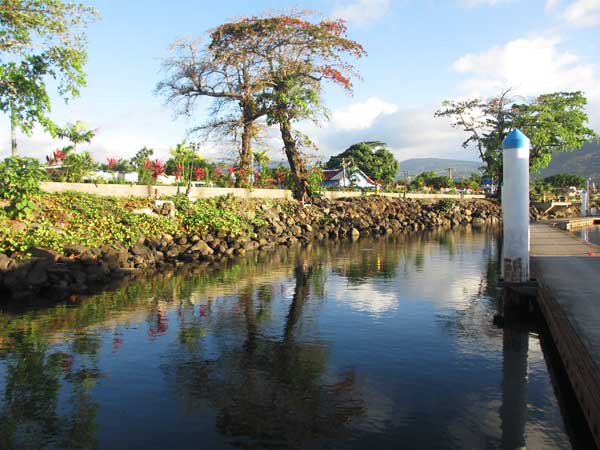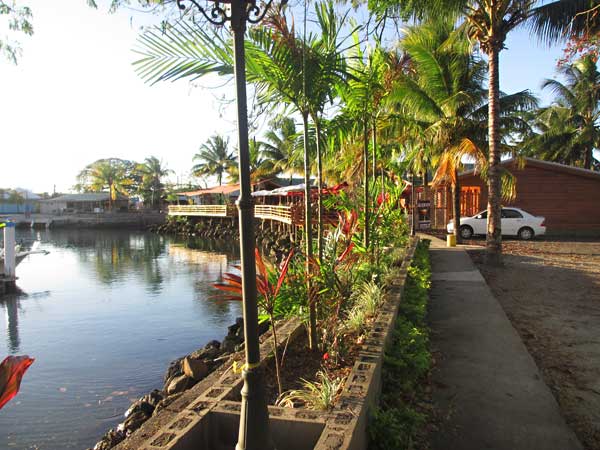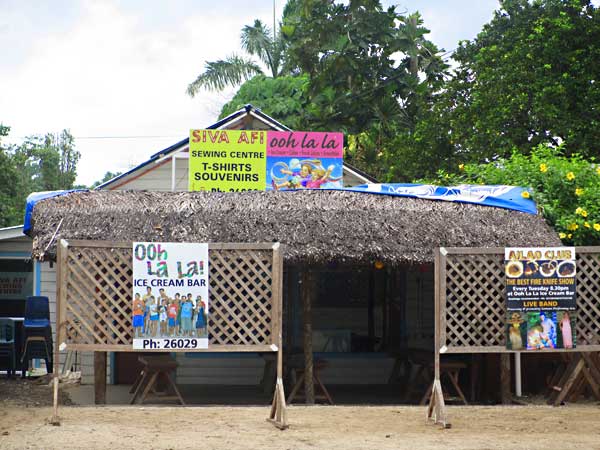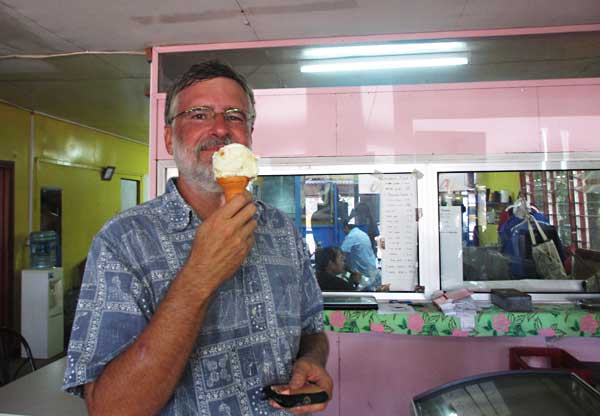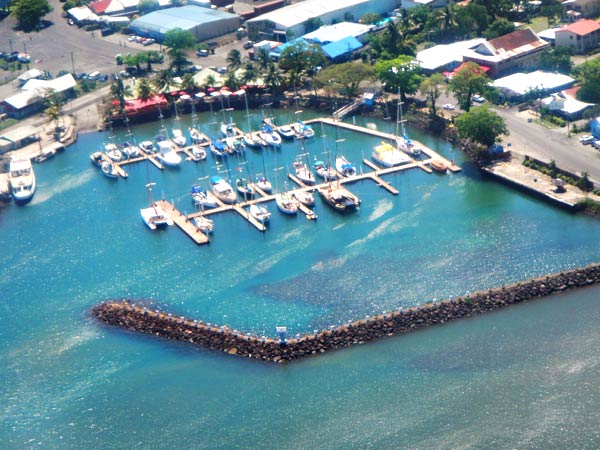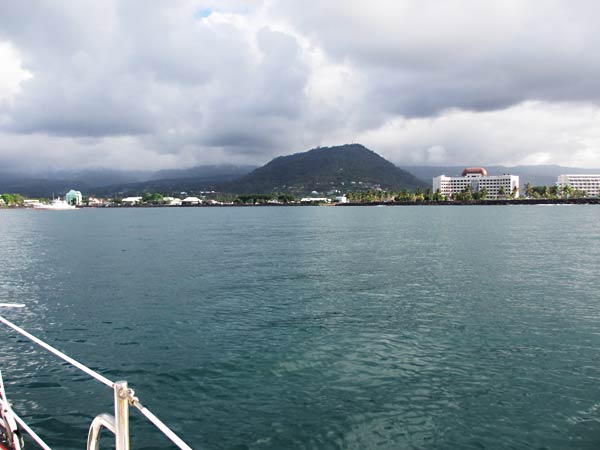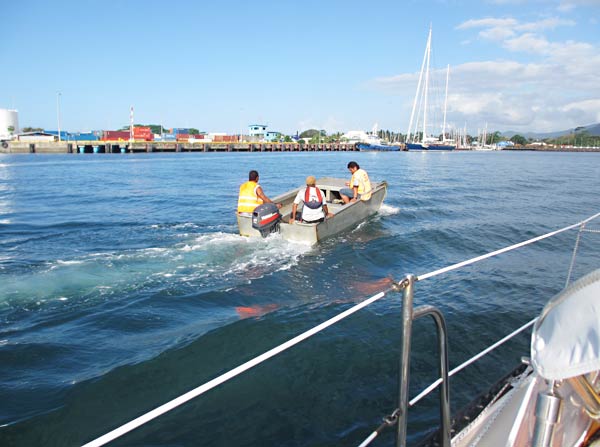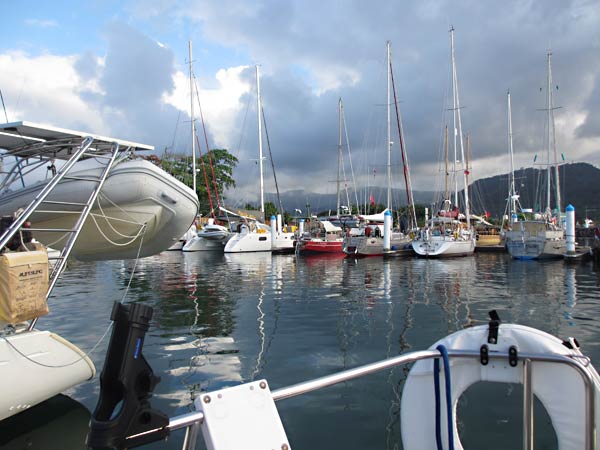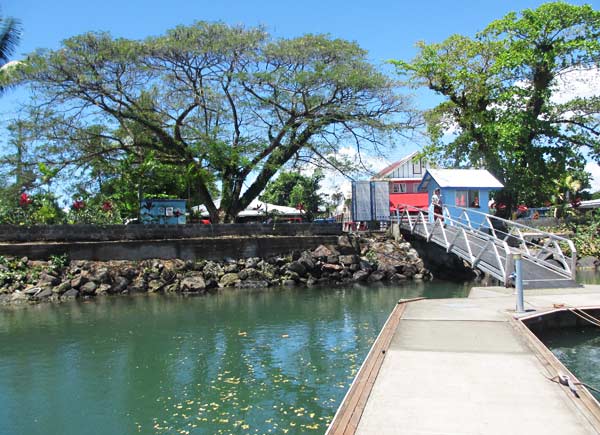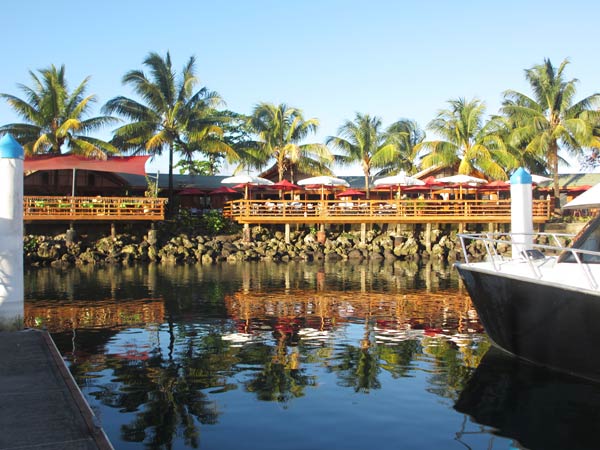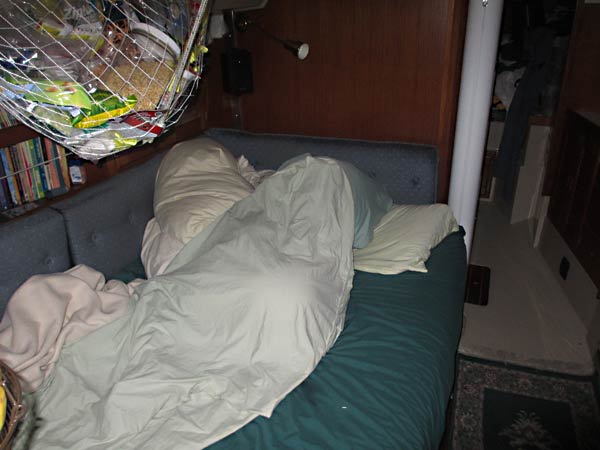September 08, 2012
Our first night here, I was awakened by the mosquitoes I’d been warned about. Our neighbor had told us that the bites don’t really itch much. Well they do itch initially but the itch fades quickly; so by the next morning the bite is gone. That’s not much comfort, though, when you wake up scratching in the middle of the night. After the third wake-up, I sprayed myself with insect repellant and sprayed sleeping Rich, too. This was the beginning of a new bedtime ritual: spraying ourselves with mosquito spray.
On Saturday morning, we waited hopefully for the marina to contact us regarding the check in as they had promised to do. But the radio silence made it apparent that the cruisers were right: no one was coming to check us in. Around 10, Rich called the marina, and we were told that customs does not work on the weekend.
When we first arrived, I had asked the guy who led us in if we could go to the restaurants right there. He asked if we had food, and I muttered something about being down to the very last of it (I am not a good liar). After he told us to stay on the boat, I wished I had lied. Today, Rich decided to try telling the marina that we’d run out of food (since they seemed concerned about this possibility yesterday). After some discussion amongst themselves, one of the marina people told us a ferry was coming in today from American Samoa and customs will be working on clearing in those passengers; so they would get one of those guys to come and check us in.
About an hour later an official showed up as we were making some tuna salad for lunch. We told him to come aboard, and I thanked him for coming out to see us today. He looked at me solemnly and slowly shook his head back and forth, and said, “We do not work on Saturday,” making it clear that although he was here, it was a grave breach of their customs. He said he had to leave church to do this. I didn’t say anything like, “Didn’t you guys just check in ferry passengers?” or “You have church on Saturday?” but instead apologized over and over for this terrible thing we were asking him to do just because we were out of food (quickly adding that the tuna salad on the counter was the last of it). He said someone has to pay for his overtime and cab fare, and I said we will do that, and he solemnly said, “Yes, you will.”
He then sat down to fill out the paperwork with us. It turned out he was the Health Inspector. The normal check-in procedure here involves a parade of people who show up your boat throughout the course of a day and fill out paperwork. The health inspector comes first, then the quarantine people, then the marina/port people, then the customs people, and finally immigration (although this last group has a tendency not to show up, forcing people to go find their office downtown). We still had to see all these people on Monday, but once we saw the Health Inspector, we could leave the boat, and that’s what we needed.
One part of these encounters with Samoan officials is that they all ask you if you’ve “been off the boat,” and then look at you suspiciously as you answer, knowing full well that many of the cruisers are lying through their teeth when they say no and trying to determine if you might be lying, too. Our official asked about 3 times, narrowing his eyes at us. It was so frustrating—if we were leaving the boat, we wouldn’t be paying extra to have him out here! I finally told him he could ask the guard! (There is a guard stationed at the marina, but I don’t think he pays much attention).
Finally we were done with the paperwork and he determined that we were healthy (by merely asking “are you healthy?”). We apologized for about the 57th time and asked him how much he needed for this special service. He said 50 tala, and as it happened we had Samoan money and were able to give him that (the money the one cruiser had lent us plus some money we exchanged with some other cruisers who were pulling out shortly after we got in). I had to give an explanation about how we had money and it sounded lame, and he narrowed his eyes again but accepted it. It’s a good thing we did have Samoan money or it probably would have cost us $50 US dollars. He finally told us to lower our quarantine flag and then we could get off the boat. Hooray!
We did get off the boat right after he left and headed straight for Ooh La La across the street, which was said to have great ice cream. It was true, the ice cream was really good. After that we took a walk around town, where we encountered the third drawback of Samoa: the relentless sales harassment from some of the locals. They have a technique: walk up to you, ask how you are and where you’re from, and then engage you in friendly conversation. That’s when they strike, trying to high-pressure you into buying whatever it is they’re selling and forcing you to be firm and a little rude in saying no.
The worst one was a cab driver who gives island tours. He befriended us before we realized how these guys operate and that they need a firm “no.” We had said “maybe later” to his proposed tour, and over the time we stayed here I nicknamed him “our Stalker.” This whole thing was not only annoying but sad in that this is actually a culture of warm and friendly people. But it got to the point if anyone on the street tried to talk to us, we’d have to beat a hasty retreat as those guys generally were trying to sell something.
As the afternoon wore on, we noticed it was getting amazingly hot. The guy on the boat next to us was right about this, too: it’s especially hot here. Hotter than anyplace were in French Polynesia, and according to him, hotter than American Samoa, which was only 80 miles away. By the time we finished walking around town, we were overheated and thinking we might not be staying in Samoa as long as we had planned.
That evening we headed straight for the restaurant where we ordered cold beer and three appetizers that were amazingly tasty. I have to say that Samoa has its drawbacks, but the food is not one of them: it is surprisingly good.
I wish I could say we were completely comfortable with all of this check-in rigamarole, but it seems that the rules are not very clear. The Health Inspector said we could get off the boat, but rumor had it the customs people would probably not agree with that, and so we should probably lie to them on Monday. I was happy to be free, but paranoid about being spotted by off-duty customs officials, or any officials.
That night before bed, we doused ourselves with mosquito spray. Closing up the boat is not an option here as we need all hatches open to catch any breezes that happen by. Thankfully, with the help of our fans, it was almost cool enough to sleep. -Cyndi
